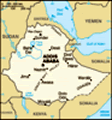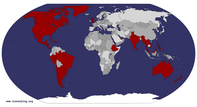Advertisement
Published: November 19th 2012
31st October ’12 Awash to Addis Ababa
So driving back to Addis today as returning there is the easiest way to then head north and there is a bit of sightseeing organised in the city for the afternoon but I doubt I will make it as I feel lousy and just need sleep!
We drove back through the volcanic landscape, passing lava fields and jagged crater peaks. We stopped at Lake Beseka where there were lots of endemic (new word for the trip) Ethiopian birds whose names I have totally forgotten and great views of the volcanoes.
Another stop was at a view point where there were lots of children, with lots of older children carrying babies strapped to their backs and once more they were all smiling, laughing and saying hello to us faranjis.
By lunch time we had reached Lake Bishaftu and we had lunch in a lovely restaurant called the Dreamland Resort overlooking the lake. It was really lovely and the food was sumptuous I had the steak sandwich which was huge and cooked Ethiopian style – which means the meat is nearly raw, they offered to cook it for longer for me but
I wanted to try it in the local style and it was gorgeous.
Eventually we arrived back at the Ghion Hotel in Addis which was the joining point at the start of the trip and we where we are staying for one night, it is much larger and grander looking than our little Addis Regency Hotel but the rooms are nowhere near as nice and neither is the food and there isn’t any free wifi so we wont be staying here at the end of the holiday. Like the Regency they have lots of uniformed doormen and gate staff who all salute when you arrive and leave!!
By now I was feeling really ill so I opted to go to bed while everyone else went to visit the Church of the Holy Trinity, the Ethnographic Museum and to pop into the National Museum to have a look at Lucy (the fossilised remains of a hominid that are at least 3.2 million years old) and Ardy (a more recent discovery and even older).
Howard reckoned I hadn’t missed much.
1st Nov ’12 Addis Ababa to Bahar Dar
I’m feeling much better today after all the extra
sleep yesterday and my ears have nearly cleared so it’s all good.
So it was an early start and a short one hour flight north to Bahar Dar which is the capital of the Amhara Region. When we landed we had a short walk across the muddy rough ground to reach the tiny tin hut which is the arrivals area and where we waited for our luggage to be brought on a cart from the plane.
As we drove to our hotel on Lake Tana on the outskirts of Bahar Dar and checked in, it’s an ex government hotel and nice enough with gardens on the lakeside. Lake Tana is the largest lake in Ethiopia and is more than 3,500 sq km and there are 37 islands within the lake and 20 of them have monasteries on them!
We took a boat trip out onto the lake to visit Ura Kidane monastery, it took an hour to reach the island and then we had a rocky muddy walk up hill to the monastery, past lots of little souvenir stalls – icon anyone?
When we finally made it to the top and stepped through the gate we
saw a couple of circular buildings and could hear chanting – it turned out a mass was taking place and we weren’t allowed in! Sue was not a happy bunny and rightly had a go at the local guide for not knowing in and avance and letting us hike up the hill for nothing. Especially Sheila who only has one leg!
As the mass was going to last for 3 hours we all picked our way back down the hill, did and bit of shopping (aka spreading love and happiness), had a drink and then it was back on the boat and a quick 5 minute journey to an alternative monastery on a nearby island.
Aswa Mariam monastery church was just a short walk and was a beautiful round building made of wood and rattan with a thatched roof. There was an outer corridor that was undecorated and used by people for chanting, then you stepped through the huge wooden doorways into an inner circular corridor which led to the entrance doors for the holy of the holies was. These walls were highly decorated with paintings depicting scenes from the bible, Jesus’s life, the Apostles and Angels. The
paintings were brightly coloured and painted on cloth which was then fixed onto the walls.
Apparently when an artist wants to paint for the church they first have to prove the standard of their work is good enough and they do this by producing rough sketches on the outer doors.
This inner corridor area is where communion is taken. As services last for hours the people have long tall prayer sticks with a kind of grooved top and they are used to prop themselves up or support themselves with as everyone (unless ill or pregnant) has to stand for the entire time.
The Holy of the Holies is the inner sanctum where the replica Arc of the Covenant is kept (all churches have one) and only the Priests or Deacons are allowed to enter, huge curtains block the view from prying eyes!
It was a beautiful, tranquil little church in a lovely grassy compound with a stone bell – a long oblong shape piece of rock hung by wires with a stone to strike it. This is used to summon the villages in a case of emergency.
On the way back to the boat we
stopped off for a coffee ceremony and very unusually this was actually performed by a man. Then it was back across the lake to our hotel.
2nd Nov ’12 Bahar Dar and the Tissiat Falls
Today we visited the Tissiat Falls which Amharic for ‘water that smokes’ and is fed by Lake Tana which is the outlet of the source of the Blue Nile. The river has been damed for 10 years and as a result the falls have been a fraction of their original size, but we were lucky and today the dam was open!!
So we arrived in the village of Tis Isat and while the tickets were being bought we found ourselves surrounded by villagers desperately trying to sell us their wares – and very nice they were too.
Then we set off walking and began by going down a steep rocky section of pathway to a 16th century Portuguese bridge which crossed the Blue Nile. The countryside was beautiful, all green hills dotted with trees and we climbed up another hill and past a tiny village of round ‘wattle and daub’ thatched huts where children came out to see the faranji and
called out hello and waved to us. One lady showed us how they make injira on a giant metal plate balanced over an open fire and then store it in big round baskets.
At the top of the hill was the first view of a section of the falls, a great thundering body of water and as we followed the ridge along we saw more and more falls merging to make the mighty Tissiat Falls, which are reckoned to be one of the best in Africa and they certainly are a stunning sight.
Walking down towards the river we spotted the suspension bridge which we needed to cross. This had been built for the locals to save them miles of walking up stream to the old crossing point. I just stared straight ahead and tried not to look down as I went over it as you could see just how deep the drop was through the slats!
Up the top of the hill on the other bank there were a couple of shacks set up for coffee ceremonies and a whole host of people – men, women and children and a few cows and goats waiting to
greet us. They were all looking out for Sue and her photos! Very few people begged so I guess the photo idea is working. There were the usual handicrafts and souvenirs for sale but it was all done with big smiles so it was very hard to resist!
After a last look at the falls we carried on walking passing people spinning wool by hand, through fields of crops, spotting lots of brightly coloured birds and eventually came to the river bank again. Here we waited for the ‘ferry’ to take us back down the Blue Nile to the village on the other side.
The ‘ferry’ was so small we had to split up and while we waited in the village for the other half of the group we chatted to the local people – a lot of them were students who wanted to practise their English, watched village life carrying on and admired the blankets spread out in the road which were covered with chillis drying in the sun. We drove back to Bahar Dar passing young boys herding cattle along the road, in and out of the traffic.
That afternoon we drove out to see

 Tissiat Falls
Tissiat Falls
Portugese BridgeHaile Selassie’s Palace, which he had only used for a couple of nights. However the road was being resurfaced so we couldn’t go along the tree lined grand road and ended up on a massive detour through the obviously more wealthy village suburbs which was actually really interesting.
We got to the Palace – a very 70s inspired building which is closed to the public but the nice guard let us peer through the fancy iron work gates and take photos.
Carrying on back towards town we stopped at the viewpoint of the ‘outlet of the source of the Blue Nile’ got great views and mildly harassed by young students looking for sponsors and then stopped again at the memorial for the Maryrs of the Derg. This was a simple but striking memorial symbolising all the thousands of men, women and children who died during this period.
Then it was back into the hustle and bustle of the town and then the tranquillity of our hotel and its lake side gardens.
Advertisement
Tot: 0.077s; Tpl: 0.013s; cc: 11; qc: 28; dbt: 0.0468s; 1; m:domysql w:travelblog (10.17.0.13); sld: 1;
; mem: 1.1mb
























